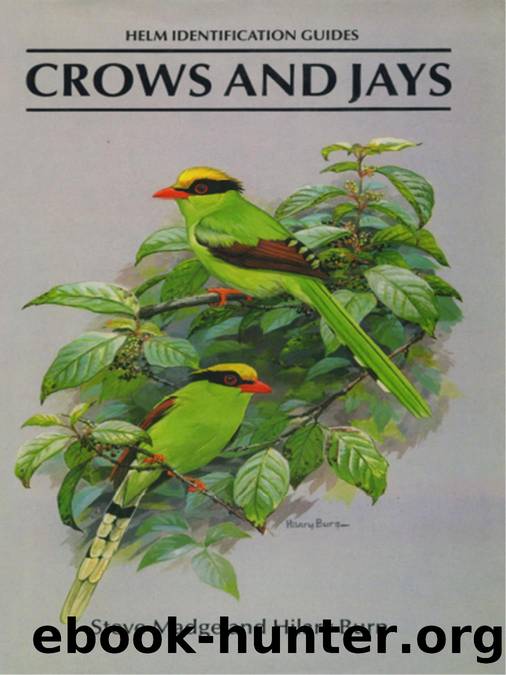Crows and Jays by Steve Madge

Author:Steve Madge
Language: eng
Format: epub
ISBN: 9781408131695
Publisher: Bloomsbury Publishing
Published: 2019-11-23T00:00:00+00:00
SPOTTED NUTCRACKER Plate 12
Nucifraga caryocatactes
Alternative names: Nutcracker, Eurasian Nutcracker
A beautifully marked crow, widespread in pine forests of Europe and Asia. Notable for its dependance on the Arolla Pine, although some populations feed principally on hazel-nuts.
IDENTIFICATION: Distinctive short-tailed, broad-winged corvid of coniferous forests. At long ranges appears all dark with white ventral region and tail corners, but closer views reveal profuse white spotting over entire body; populations of China and the Himalayas have small and indistinct spotting and even at moderate ranges appear merely brownish on body with blacker crown and wings, but show very striking white in tail and on vent like northern races. Relatively short tail and long bill give a distinctive silhouette when perched on tree top or in flight. Flight action, size and shape recalls a short-tailed Jay but white ventral region and most of tail underside gives an impression of a dark stocky bird with completely white rear end from below. On breeding grounds harsh calls attract attention, the bird usually calling from the top of a tall tree. See also Larger-spotted Nutcracker which is treated separately.
DESCRIPTION: Length 32â34 cm. Race macrorhynchos: Bill relatively long, pointed. Nasal tufts short and dense, whitish. Tail medium-short, slightly rounded at the corners. Crown and nape dark brown, darkest on forecrown. Lores white. Sides of head, neck and most of body plumage dark brown profusely marked with white, densest on sides of head where becomes almost whitish on face; spots largest on breast and most sparse on flanks and scapulars; rump and uppertail-coverts unmarked dark brown. Lower belly and undertail-coverts white. Wings glossy black, covert feathers tipped with white (chiefly lesser coverts). Underwing similar. Tail glossy black with broad white feather tips, increasing in extent towards outermost but only narrowly on central feathers; white most extensive from below with black visible only as narrow band at tail base when tail closed. Bill and legs black. Irides dark-brown.
AGE/SEX: Plumages similar; juvenile duller, with unglossed wings and tail and smaller body spotting. By first autumn may be aged by some retained juvenile drab wing feathers, including white edge to tips of greater coverts (adults can have small white arrow-head marks here); ventral and lower nape plumage looser and softer in texture than adult. Much as adult by first spring.
MEASUREMENTS: Male averages slightly larger than female. Nominate race: wing 173â195, tail 115â136, tarsus 40â45, bill 39â52, weight 124â200.
GEOGRAPHICAL VARIATION: Eight subspecies, falling into two groups, are recognised here. However as might be expected from a largely sedentary, specialised, mountain forest bird a number of other races have been described which have involved local variations linked by clines. Some of the races listed here might be better linked in this way on a broader front e.g. hemispila-macella-interdicta (see Vaurie 1954). The well-marked form of the north-west Himalayas, multipunctata, is very distinct and does not fall into the pattern of clinal variation; as it virtually meets hemispila and retains its differences (although limited hybridisation is known) it is given separate treatment here as a potentially good species.
Download
This site does not store any files on its server. We only index and link to content provided by other sites. Please contact the content providers to delete copyright contents if any and email us, we'll remove relevant links or contents immediately.
The Lonely City by Olivia Laing(4766)
Animal Frequency by Melissa Alvarez(4422)
All Creatures Great and Small by James Herriot(4264)
Walking by Henry David Thoreau(3919)
Exit West by Mohsin Hamid(3789)
Origin Story: A Big History of Everything by David Christian(3663)
COSMOS by Carl Sagan(3581)
How to Read Water: Clues and Patterns from Puddles to the Sea (Natural Navigation) by Tristan Gooley(3427)
Hedgerow by John Wright(3311)
How to Read Nature by Tristan Gooley(3286)
The Inner Life of Animals by Peter Wohlleben(3281)
How to Do Nothing by Jenny Odell(3260)
Project Animal Farm: An Accidental Journey into the Secret World of Farming and the Truth About Our Food by Sonia Faruqi(3187)
Origin Story by David Christian(3167)
Water by Ian Miller(3149)
A Forest Journey by John Perlin(3041)
The Plant Messiah by Carlos Magdalena(2898)
A Wilder Time by William E. Glassley(2832)
Forests: A Very Short Introduction by Jaboury Ghazoul(2813)
